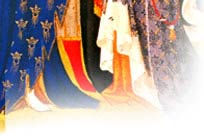 |
|||
 

|
Asia during the Middle Ages Marco Polo was not the first Westerner to travel to the Orient and return with amazing stories of this different culture, but his accounts published in the late 13th and early 14th centuries were the first to be widely read throughout Europe. Medieval Asia had far surpassed the West in the development of warfare, communication and science. Gunpowder was widely used as early as the 11th century and they were using moveable type printing five hundred years before Gutenberg created his press. Buddhism, Taoism, Confucianism were the dominant philosophies of the Far East during the Middle Ages. Medieval Asia was the kingdom of the Khans. Never before had any person controlled as much land as Genghis Kahn. He built his power unifying separate Mongol tribes before expanding his kingdom south and west. He and his grandson, Kublai Khan, controlled lands in China, Burma, Central Asia, Russia, Iran, the Middle East, and Eastern Europe. Estimates are that the Mongol armies reduced the population of China by nearly a third. Genghis Khan was a pagan who tolerated nearly every religion except Islam, and their culture often suffered the harshest treatment from Mongol armies. The Khan armies pushed as far west as Jerusalem before being defeated in 1260. The Middle Ages were an unsurpassed era for Chinese ceramics and painting. Medieval architectural masterpieces such as Angkor Wat in Cambodia, the Great South Gate in Todaiji, Japan, and the Tien-ning Temple in Peking, China are some of the surviving constructs from this era. The Black Death, which would later ravage Western Europe had its beginnings in Asia, where it wiped out large populations in China in 1331. China flourished again late in the medieval era during the famed Ming Dynasty. In Japan these later Middle Age centuries saw a return to the traditional Shinto faith and the continuing popularity of Zen Buddhism. |
 |
|
 |
|||
 |
|||